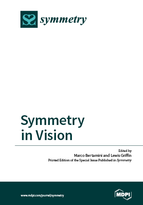Symmetry in Vision
A special issue of Symmetry (ISSN 2073-8994).
Deadline for manuscript submissions: closed (31 December 2016) | Viewed by 86961
Special Issue Editors
Interests: visual cognition; perception of shape; object representation; intuitive physics; art and perception
Special Issues, Collections and Topics in MDPI journals
Special Issue Information
Dear Colleagues,
Symmetry has a central role in the study of vision. The concept of symmetry has an ancient origin in considerations of visual appearance; in modern times, abstracted and formalized into Group Theory, it has found spectacular applications, far beyond the visible; but its importance for vision persists in many ways including:
- As a non-accidental feature of an image that cues affordances, 3D structure or the semantic categories of object present.
- As a redundant aspect of an image which many be exploited for simplicity and compactness of encoding.
- As a salient feature that draws attention, and evokes distinctive brain responses.
- As a constraint on priors on the distribution of structures to be found in the natural world.
- As an aesthetic principle.
- As a design principle for vision systems.
The original idea for a Special Issue came from a symposium at the European Conference in Visual Perception, in 2015, on the topic of brain responses to visual symmetry, but we have now extended the scope. This Special Issue is devoted to provide a shared place for cutting edge studies on how and why symmetry is processed and exploited by biological and artificial visual systems.
Prof. Dr. Marco Bertamini
Prof. Dr. Lewis Griffin
Guest Editors
Manuscript Submission Information
Manuscripts should be submitted online at www.mdpi.com by registering and logging in to this website. Once you are registered, click here to go to the submission form. Manuscripts can be submitted until the deadline. All submissions that pass pre-check are peer-reviewed. Accepted papers will be published continuously in the journal (as soon as accepted) and will be listed together on the special issue website. Research articles, review articles as well as short communications are invited. For planned papers, a title and short abstract (about 100 words) can be sent to the Editorial Office for announcement on this website.
Submitted manuscripts should not have been published previously, nor be under consideration for publication elsewhere (except conference proceedings papers). All manuscripts are thoroughly refereed through a single-blind peer-review process. A guide for authors and other relevant information for submission of manuscripts is available on the Instructions for Authors page. Symmetry is an international peer-reviewed open access monthly journal published by MDPI.
Please visit the Instructions for Authors page before submitting a manuscript. The Article Processing Charge (APC) for publication in this open access journal is 2400 CHF (Swiss Francs). Submitted papers should be well formatted and use good English. Authors may use MDPI's English editing service prior to publication or during author revisions.







